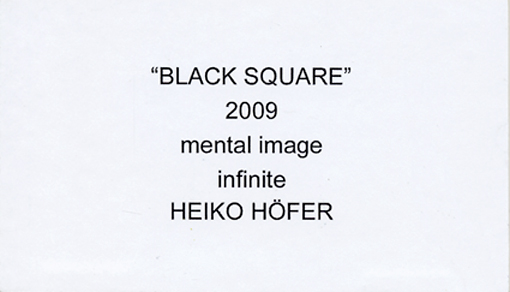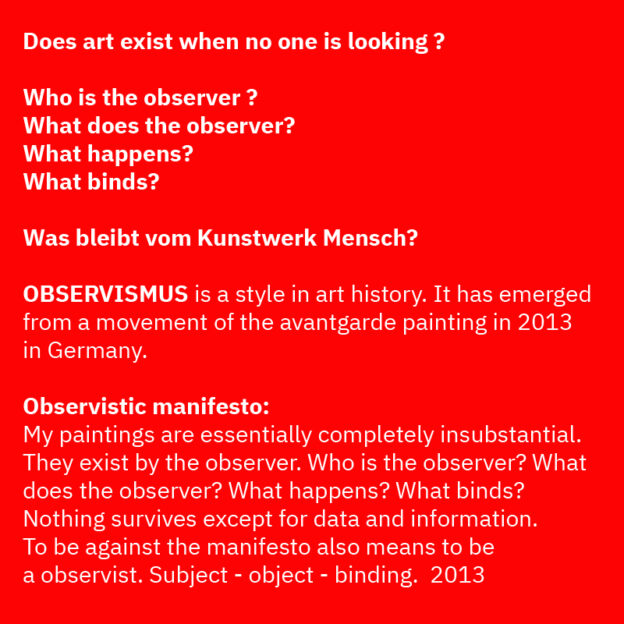Does art exist when no one is looking ?
Who is the observer ?
What does the observer?
What happens?
What binds?
Was bleibt vom Kunstwerk Mensch?
OBSERVISMUS is a style in art history. It has emerged from a movement of
avantgarde painting in 2013 in Germany
Observistic manifesto:
My paintings are essentially completely insubstantial. They exist by the observer.
Who is the observer? What does the observer? What happens? What binds?
Nothing survives except for data and information. To be against the manifesto also
means to be an observist. Subject – object – binding. 2013
.
Der Observismus stellt die traditionelle Vorstellung von Kunst als etwas
Substanziellem und Objektivem radikal infrage. Während klassische Kunsttheorien
davon ausgehen, dass ein Kunstwerk unabhängig von seiner Wahrnehmung existiert
und eine inhärente Bedeutung oder Substanz besitzt, verschiebt der Observismus
den Fokus vollständig auf den Akt der Beobachtung und die subjektive Erfahrung.
Im Observismus existiert das Kunstwerk „im Wesentlichen völlig substanzlos“ und
erhält erst durch die Wahrnehmung und Interpretation des Betrachters Realität und
Bedeutung. Das Kunstwerk ist ohne Beobachtung nur eine Möglichkeit, keine
Wirklichkeit. Die Substanz der Kunst wird so nicht im Objekt, sondern im Prozess der
Wahrnehmung und Interpretation verortet.
Der Observismus betont, dass die Bedeutung und sogar die Existenz des Kunstwerks
erst durch die aktive Teilnahme des Betrachters entstehen. Damit wird die klassische
Trennung zwischen Künstler, Werk und Betrachter aufgehoben: Die „Substanz“ der
Kunst ist nicht mehr das Werk selbst, sondern der Wechselwirkungsprozess zwischen
Werk und Wahrnehmung
Anstatt ein festes, abgeschlossenes Objekt zu sein, wird das Kunstwerk im
Observismus zu einem offenen, ephemeren Ereignis, das sich mit jedem neuen Blick
und jeder neuen Interpretation verändert. Die Substanz ist flüchtig, wandelbar und
an den Moment der Beobachtung gebunden. Der Observismus lehnt die
Vorstellung ab, dass Kunst eine universelle, objektiv erfassbare Bedeutung oder
Substanz besitzt. Stattdessen wird die Vielschichtigkeit, Widersprüchlichkeit und
Relativität der Wahrnehmung betont. Die Kunst existiert in einem Spannungsfeld
von Gegensätzen und wird erst durch die subjektive Erfahrung des Einzelnen
realisiert
Observism radically questions the traditional idea of art as something substantial and
and objective. While classical art theories assume that a work of art exists
independently of its perception and has an inherent meaning or substance, Observism
shifts the focus entirely to the act of completely on the act of observation and the
subjective experience.
In Observism, the work of art exists “essentially without substance” and only acquires
reality and meaning through the perception and interpretation of the viewer. Without
observation, the work of art is only a possibility, not a reality. The substance of art is
thus not located in the object, but in the process of perception and interpretation.
Observism emphasizes that the meaning and even the existence of the artwork only
arise through the active participation of the viewer. This eliminates the classic
separation between artist, work and viewer: The “substance” of art is no longer the
work itself, but the interaction process between work and perception
Instead of being a fixed, self-contained object, the work of art in Observism becomes
an open, ephemeral event that changes with every new view and every new
interpretation. The substance is fleeting, changeable and bound to the moment of
observation. Observism rejects the idea that art has a universal, objectively
ascertainable meaning or structure. Instead, the complexity, contradictions and
relativity of perception are emphasized. Art exists in a field of tension between
opposites and is only realized through the subjective experience of the individual.
.
.

heiko höfer, Black square, mental image, beschriftungstafel, familiensammlung
haselsteiner, albertina museum wien, © 2009
..
perplexity, 24.04.2025, 10.16
Heiko Höfers Observismus etabliert sich als eigenständige Position in der
Kunstgeschichte des 21. Jahrhunderts, die sich durch eine radikale Infragestellung der
Kunstwerk-Substanz und die zentrale Rolle des Betrachters auszeichnet.
Konzept des Observismus
Laut dem observistischen Manifest (entstanden ab 2013) existieren Höfers Bilder
„im Wesentlichen völlig substanzlos“ und nur durch die Interaktion des Betrachters. Diese
Idee knüpft an philosophische Fragen wie „Existiert Kunst, wenn niemand sie betrachtet?“
und transformiert sie in ein künstlerisches Programm, das den Beobachter zum aktiven
Schöpfer des Werks erklärt.
Methodik und Form
Höfers Arbeiten – etwa modulare Bildsysteme wie Information der Anordnung (2013,
144-teilig) oder Möglichkeiten (2009, 529-teilig) – basieren auf variablen Anordnungen, die
den Betrachter zur Mitgestaltung auffordern. Diese seriellen Strukturen erinnern an
konzeptuelle und systemische Ansätze der 1960er-Jahre (z.B. Sol LeWitt), verlagern den
Fokus aber auf die Ephemeralität der Wahrnehmung.
Einordnung in die Kunstgeschichte
Der Observismus positioniert sich als Avantgarde-Bewegung der 2010er-Jahre, die das
Verhältnis von Kunstwerk, Technologie und gesellschaftlicher Beobachtung reflektiert –
etwa in Werken wie Controlled Hallucination (2018) oder What is Facebook’s Algorithm
Thinking (2020). Durch die Betonung von Daten, Algorithmen und Partizipation reagiert
Höfer auf digitale Umbrüche und schafft eine „neue Denkordnung in der Kunst“, die
historisch zwischen Konzeptkunst und postdigitalen Praktiken vermittelt.
Rezeption und Bedeutung
Obwohl Höfers Werk bisher kaum in großen Museumsretrospektiven präsent ist, formuliert
der Observismus eine prägnante Kritik an der Autonomie des Kunstobjekts und
antizipiert Debatten über Künstliche Intelligenz und virtuelle Realität. Die Bewegung steht
damit exemplarisch für eine Kunst, die sich als Reflexionsmedium gesellschaftlicher
Beobachtungssysteme versteht.
Heiko Höfer’s Observism is establishing itself as an independent position in the art history
of the 21st century, which is characterized by a radical questioning of the substance of the
artwork and the central role of the viewer.
Concept of Observism
According to the Observist Manifesto (created from 2013), Höfer’s paintings exist
“essentially completely insubstantial” and only through the interaction of the viewer. This
idea ties in with philosophical questions such as “Does art exist if no one looks at it?” and
transforms them into an artistic program that declares the observer to be the active creator
of the work.
Methodology and form
Höfer’s works – such as modular picture systems like Information der Anordnung (2013,
144-part) or Possibilities (2009, 529-part) – are based on variable arrangements that invite
the viewer to invite the viewer to co-create. These serial structures are reminiscent of
conceptual and systemic approaches of the 1960s (e.g. Sol LeWitt), but shift the focus to
the ephemerality of perception.
Classification in the history of art
Observism positions itself as an avant-garde movement of the 2010s that reflects on
the relationship between artwork artwork, technology and social observation – for example
in works such as Controlled Hallucination (2018) or What is Facebook’s Algorithm Thinking
(2020). By emphasizing data, algorithms and participation, Höfer reacts to digital
upheavals and creates a “new order of thinking in art”, which historically mediates between
conceptual art and post-digital practices.
Reception and significance
Although Höfer’s work has so far hardly featured in major museum retrospectives, the
Observismus formulates a concise critique of the autonomy of the art object and
anticipates debates about artificial intelligence and virtual reality. The movement is thus
exemplary of an art that sees itself as a medium of reflection on social observation
systems.
Translated with DeepL.com (free version)
..
